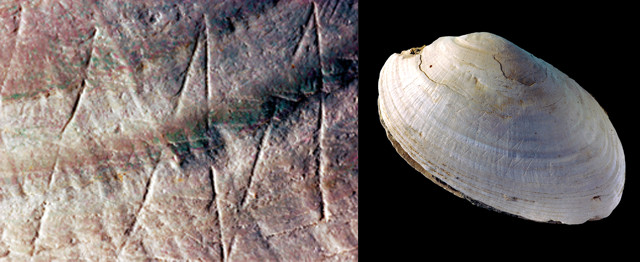
by Mary Caperton Morton Monday, March 9, 2015

An etched zigzag pattern carved by Homo erectus adorns this roughly half-million- year-old mussel shell found on the Indonesian island of Java. Credit: both: Wim Lustenhouwer, VU University Amsterdam.
Artistic expression has been called one of the hallmarks of modern Homo sapiens and Neanderthals, with the first known art forms dating to about 100,000 years ago. Now, the discovery of etchings on a mussel shell dated to between 540,000 and 430,000 years ago may mean the first artwork came from Homo erectus instead.
The zigzag patterns, carved into a mussel shell collected in Java, are the earliest known example of ancient humans deliberately creating a pattern. “It rewrites human history,” said Stephen Munro from the Australian National University in Canberra, who co-authored a new study on the find, in a statement. “This is the first time we have found evidence for Homo erectus behaving this way.”
“Although it is at present not possible to assess the function or meaning of the engraved shell, this discovery suggests that engraving abstract patterns was in the realm of Asian Homo erectus cognition and neuromotor control,” the team wrote in Nature.
The team also found evidence that Homo erectus opened the shell by boring a hole through it with a shark’s tooth, targeting the muscle that kept the shell shut. “It’s evidence that Homo erectus exploited these aquatic food sources and fits with other evidence that they probably foraged in and around water,” Munro said.
© 2008-2021. All rights reserved. Any copying, redistribution or retransmission of any of the contents of this service without the expressed written permission of the American Geosciences Institute is expressly prohibited. Click here for all copyright requests.